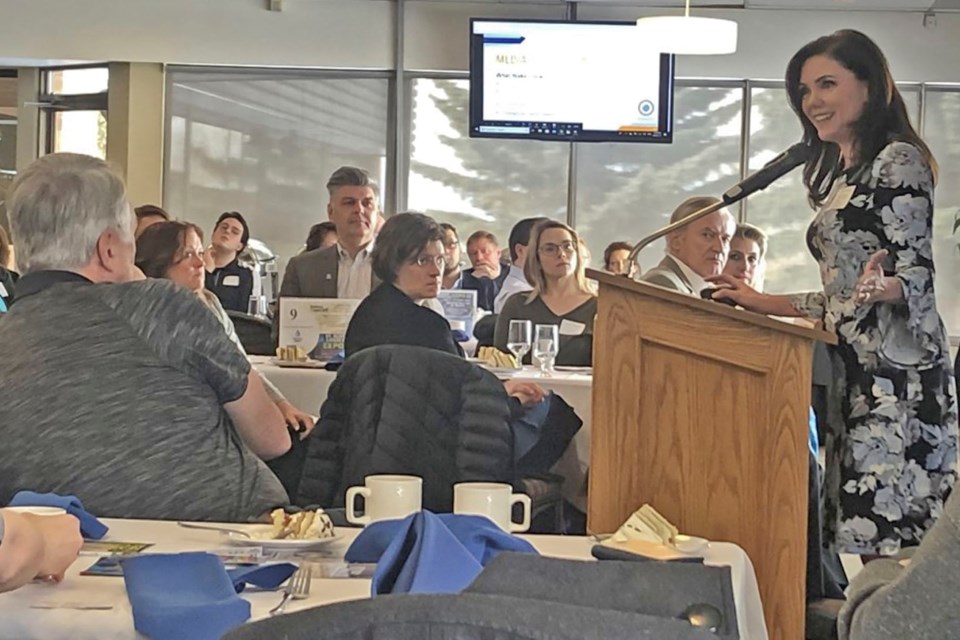A former television journalist spoke to the St. Albert and District Chamber of Commerce Wednesday about how building partnerships with media can protect reputations and open up opportunities.
Shawna Randolph has nearly 30 years of combined experience in journalism, most recently as the co-host of CTV-2’s Alberta Primetime show, and media relations. Her communications firm has advised clients including the City of Edmonton, the Royal Alberta Museum, and the Town of Morinville.
To begin her presentation, Randolph asked the room of business owners, elected municipal officials and non-profit leaders a question: “Who just loves the idea of interacting with members in the news media? Show of hands.”
Only a few hands stood out in the crowd.
“It’s very common that there’s only a handful of you who are crazy like myself – I mean, I live for it,” she said. “I think a big reason is because so many people are just scared out of their minds if you’re dealing with the media.
“But what you really need to understand is that they aren’t all that scary, honestly.”
When working with the media, there needs to first be an understanding of what is going on in their world, Randolph said.
Reporters are there to educate the public of what’s going on in everyone’s day-to-day lives, while also making money for their media outlet, in the most compelling, engaging way possible.
Juggling multiple stories at once, journalists must convince people directly affected to an interview, compile information and statistics, gather visual elements like video and photography, and write the story in a clear, concise way – all before looming, often daily, deadlines.
Not to mention responsibilities to manage social media and online traffic.
As a former broadcast reporter, Randolph said she knows these pressures well.
“The people you’re dealing with, they’re doing a job, right? And they have to get it done. But you need to have this knowledge so that you know what you need to do on your end to be advantageous and get what you want,” she said.
“Many times people say, 'Well, I have to deal with the media.' It’s more like interact with, or work together, in a sense.”
So what can people do to get their message on a reporter’s radar?
“Here’s the biggest tip, and this is the number one thing – spoonfeed them. Do the work for them,” she said.
Randolph gave an example of the work she did recently on behalf of the Arts and Heritage Foundation of St. Albert.
To get the word out about a film screening about the history of Ukrainian internments during World War I, she contacted St. Albert Gazette reporter Scott Hayes with information about the event.
To bring in a human perspective, Randolph connected Hayes with Jerry Bayrak, whose ancestors were at the Spirit Lake internment camp in Quebec.
“The result was this great story that was published to promote our film. What happened? We filled the museum viewing area that day,” she said.
Building trust with media partners is also essential to keep up good reputations. Even if a story doesn’t reflect in a positive light, people need to “face the music” and look at interviews with reporters as an opportunity to get ahead of the conversation, she said.
“If it doesn’t come from you and it comes from somebody else, you’re going to look just horrible. It’s not going to bode well, not just with media trust, but the general public’s trust."
If the person being interviewed is asked a question they aren't immediately knowledgeable on, ask the reporter for time to gather materials together, and then get back to them when ready.
“(Reporters) always have five or ten minutes, no matter what," Randolph said. "The number one thing is there always is a comment.”
Becoming your own storyteller, either through social media, online, or through visual elements like video, can also help to gain positive attention for businesses, she said.
Jennifer McCurdy, Chamber president and CEO, said she recognizes the importance of building partnerships with media outlets, looking at interviews as doors to opportunity instead of obstacles. Learning about how businesses can tell their own stories in a clear, concise way is also key.
"It's important for all of our business members, especially the not-for-profits who have limited resources, are aware of opportunities to be able to get their story out," McCurdy said.
"I think the Chamber has learned that it is a relationship, and it's making sure the information that we are providing is factual, honest and transparent. That was also a very strong message (Randolph) gave today, which is really positive for everybody."




